Projects of Former Graduate Students
 Rebecca Ayanwunmi (thesis) (MS TU)
Rebecca Ayanwunmi (thesis) (MS TU)
This project focused on quantifying the alteration of the host volcaniclastic rock and how this transformation impacted heat transfer during propagation, flow, and cooling, then basin tectonics and hydrology.

(left) Landsat image and (right) map of alteration. |
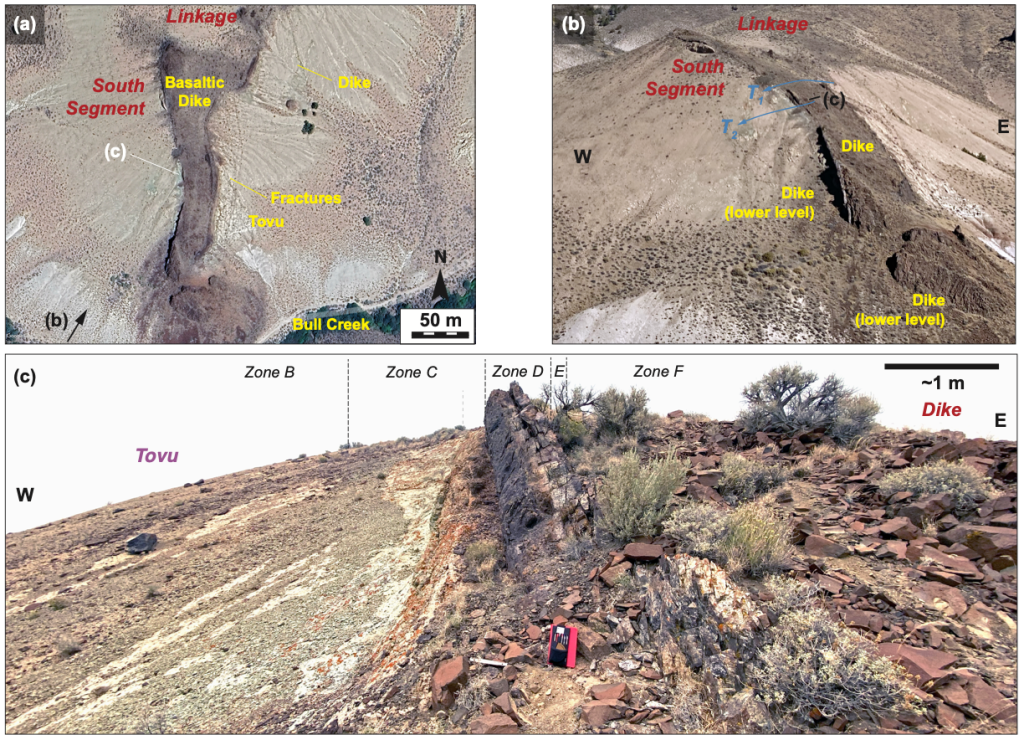
(upper left) Landsat image of dike outcrop, (upper right) view of dike from across the wash, (lower) outcrop photo of dike contact with host rock on the west side. |

Analysis of effective porosity as a function of (upper row) position and (lower row) contact metamorphic facies. |
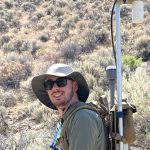 Colin Krzystek (thesis) (MS TU)
Colin Krzystek (thesis) (MS TU)
Study of the subsurface geometry of dikes in Surprise Valley to elucidate the process of injection and interaction with basin tectonics.

(left) map of dike outcrops onto Landsat image in the footwall of the Hays Canyon Fault and (right) magnetic surveys of dikes |
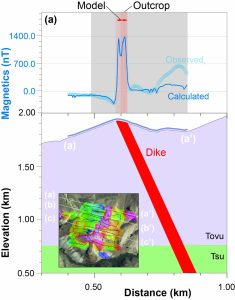
Model of magnetic anomaly. |
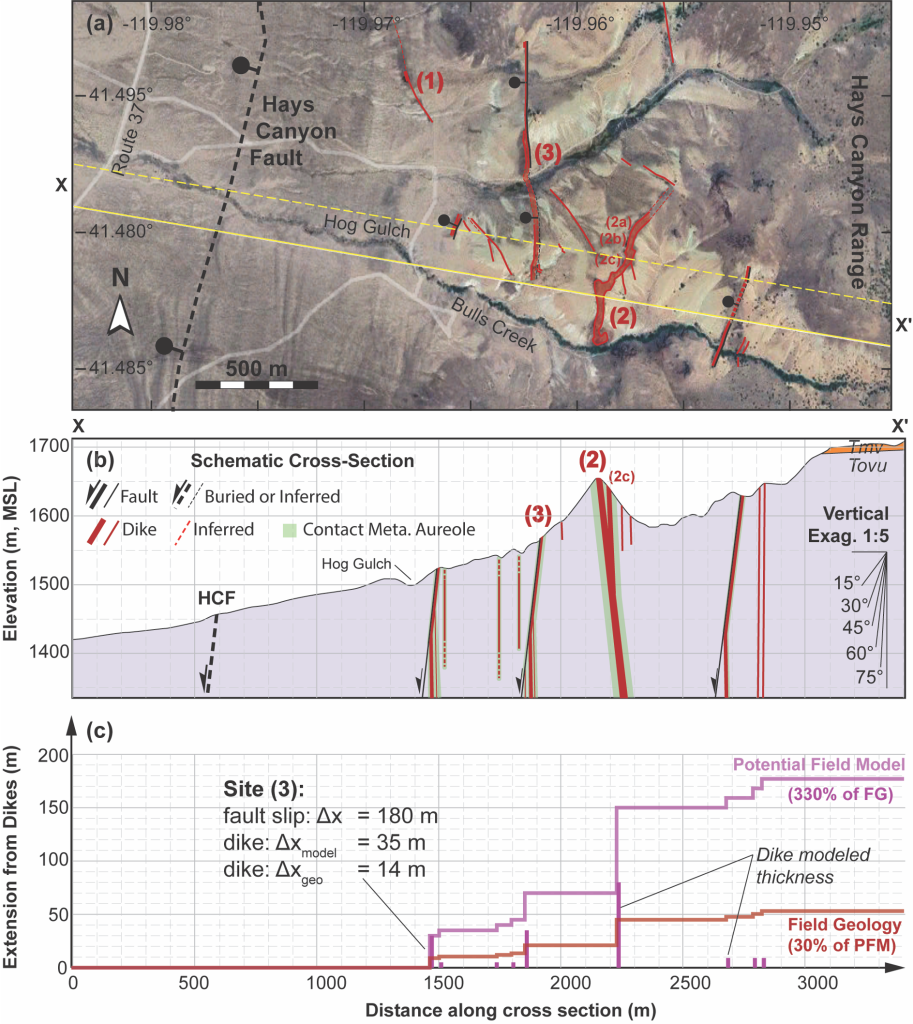
(a) map of dikes showing cross-section position; (b) cross section of dike geometry; (c) cumulative extension resulting from dike opening in the footwall of the Hays Canyon Fault. |
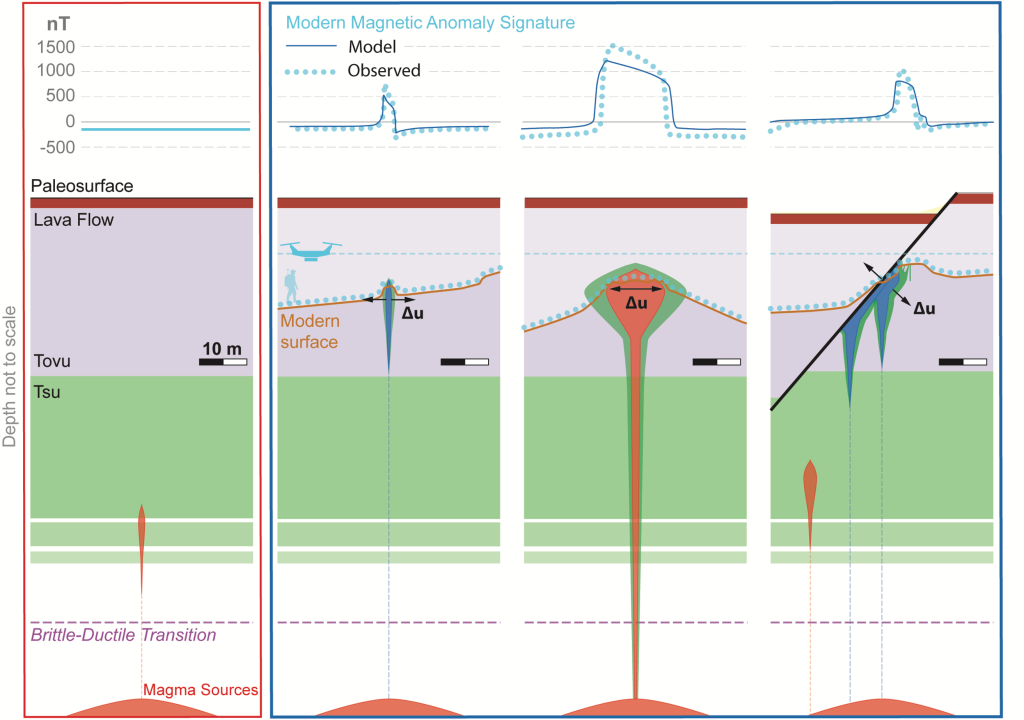
Conceptual model of the evolution of dikes in the Hays Canyon Range. |
 Breeann Stowe (thesis; paper; report) (BS, MS TU)
Breeann Stowe (thesis; paper; report) (BS, MS TU)
Analysis of core and image logs from the Mount Baker, WA temperature gradient hole.
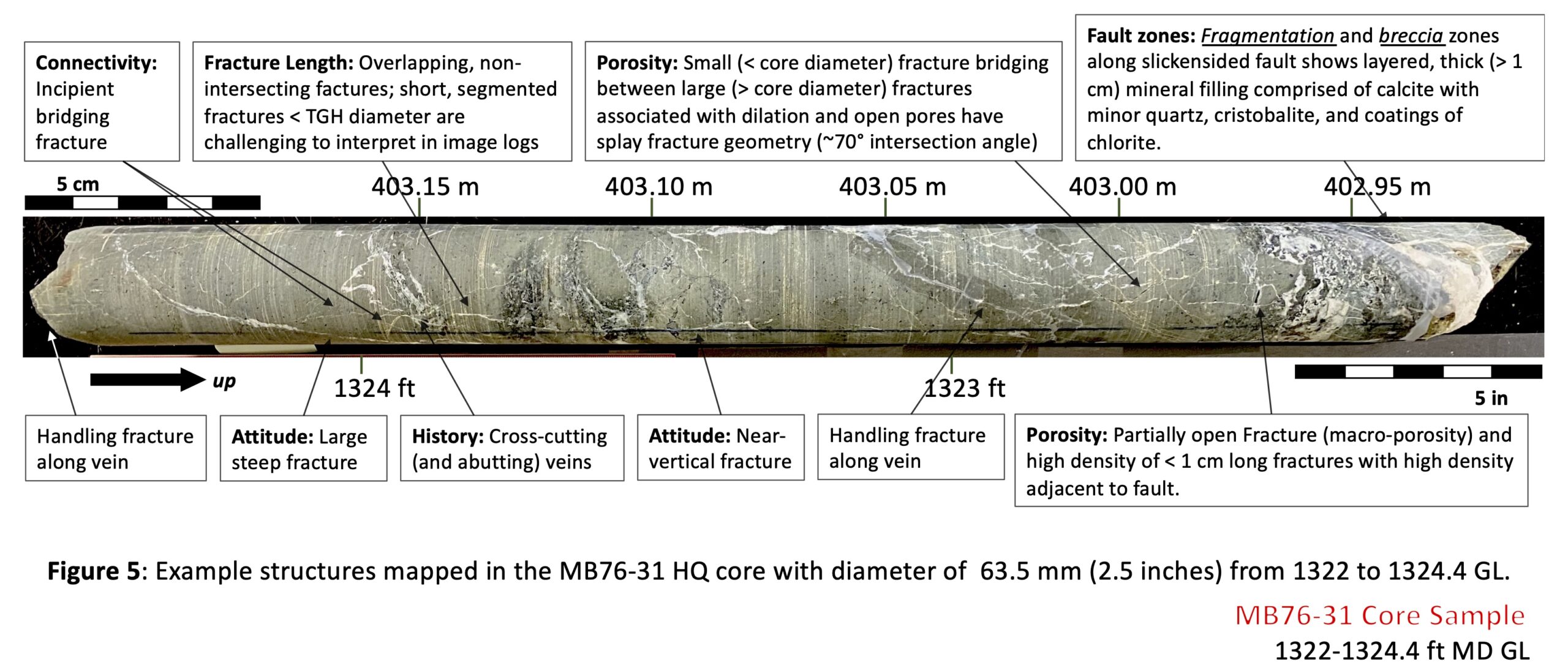 Summary of key structural features identified and mapped in core. |
 Comparison of acoustic borehole image log (left) with mapped core (right). |
 Summary of fracture population mapped in acoustic borehole televiewer log (left) and in core (right). Modified tadpole plot shows the shows the variation in fracture attitude with depth. Note the core reveals far more fractures than are mapped in the image log and a greater diversity of fracture attitude. |
- Stowe, B, D Spake, TT Cladouhos, AN Steely, and NC Davatzes. (2021) Combined Structural Analysis of Core and Image Log of TGH MB76-31 East of Mt Baker, Washington State. Geothermal Resources Council Transactions. v 45, p. 1235-1259. (Geothermal Rising, San Diego, CA October 03, 2011)
 Morgan Sawyer (thesis; abstract) (MS TU)
Morgan Sawyer (thesis; abstract) (MS TU)
Investigation of the mechanics of dikes in Surprise Valley, CA and their potential role in crustal fluid flow and geothermal resource potential.
 A series of washes reveal serial cross sections of a thin frozen dike showing its upper tip and vertical, en echelon segmentation indicating later propagation. |
 Model of dike opening in a stratigraphy of variable density. Resulting variation in buoyancy pressure produces variable opening. At the upper tip, insufficient buoyancy pressure is available to open and invade the upper tip of the dike model. Top row depicts a map view, whereas bottom row indicates a cross section through the center of the dike. First column is the tractions imposed on the dike walls due to buoyancy pressure. Middle column is the resulting opening. Right column is the horizontal stress component normal to the dike. |
- Sawyer, M, J Glen, NC Davatzes (2021) Potential role of dikes in damaging rock to support hydrothermal fluid flow, Surprise. AAPG Eastern Section Meeting, October 2-5, 2021, Pittsburg, PA
 P Drew Spake (thesis; paper; report) (MS TU)
P Drew Spake (thesis; paper; report) (MS TU)
Investigation of the geomechanical factors including fracture evolution and stress on the geothermal resource potential of Mount Saint Helens, WA.
 Left: Topographic map of Mount Saint Helens and immediate surroundings with earthquakes hypocenters and magnitude from the Pacific Northwest Seismic Network. Right: Cross-section through Mount Saint Helens aligned with the Saint Helens Seismic Zone illustrating the distribution and timing of earthquakes. |
 Position of detailed structural maps illustrating the fracture and fault patterns in the contact metamorphic aureole around intrusive igneous rock. |
 Detailed maps of the contact metamorphic facies and fracture patterns around the intrusion. |
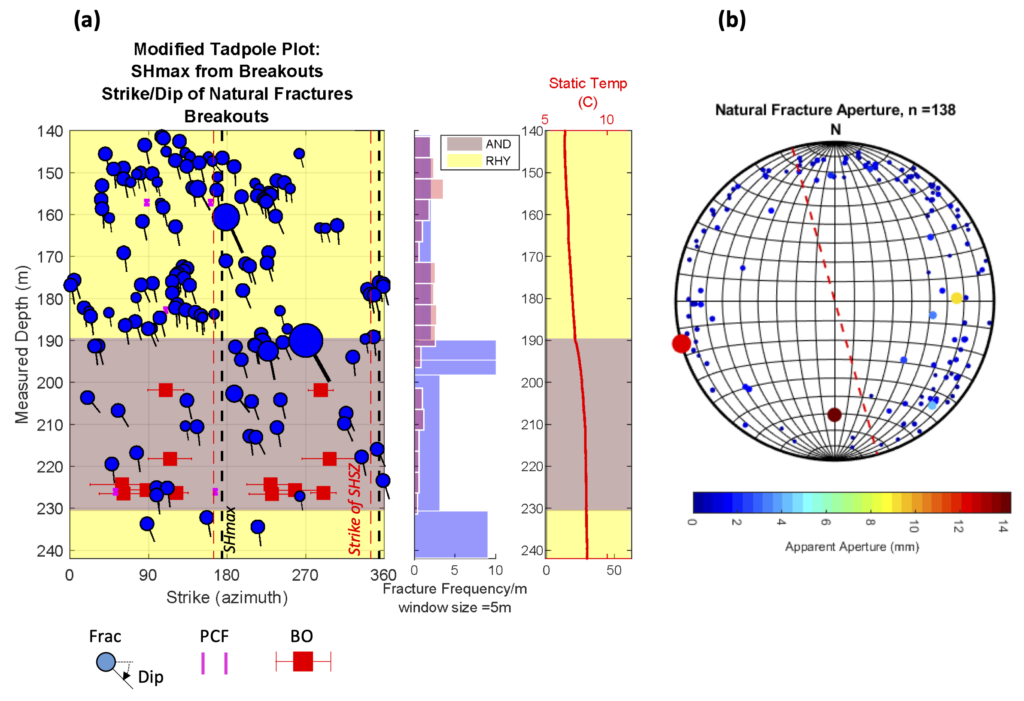 Modified tadpole plot, fracture density, static temperature, and stereogram of fracture attitude in a borehole near Mount Saint Helens. |
- D. Spake, AN Steely, TT Cladouhos, MW Swyer, C Forson, NC Davatzes, 2019, Geothermal Exploration North of Mount St. Helens: Washington State Play-Fairway Project, Workshop on Geothermal Reservoir Engineering 44, 19 p.
 Roselyne Laboso (thesis; paper; report) (MS TU)
Roselyne Laboso (thesis; paper; report) (MS TU)
Geomechanical analysis of the role of faulting in localizing fracture-hosted geothermal reservoirs at the Bradys Geothermal field, NV.
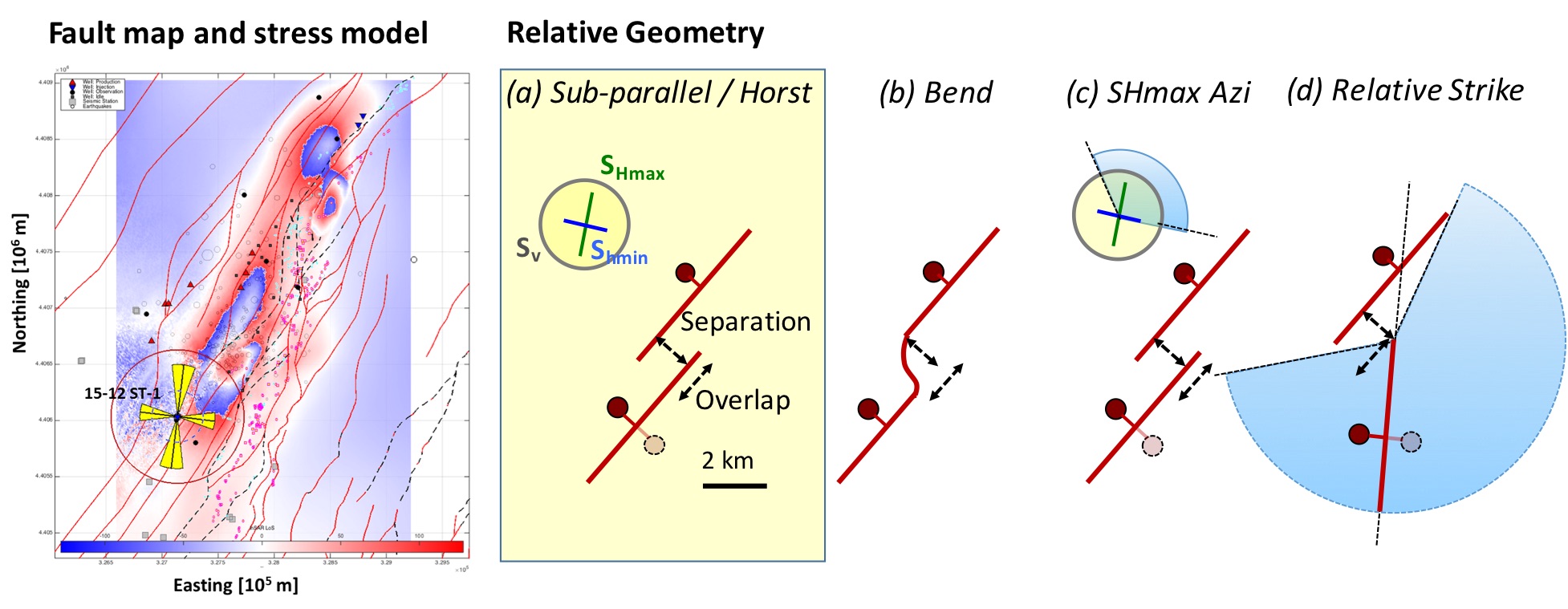 Tectonic map of surface elevation change in at the Brady Geothermal Field. The impact on the local stress state and fracture potential is explored for idealized geometries of faults in the geothermal field and compared with the distribution of subsidence, subsurface temperature, earthquake hypocenters, and well permeability. |
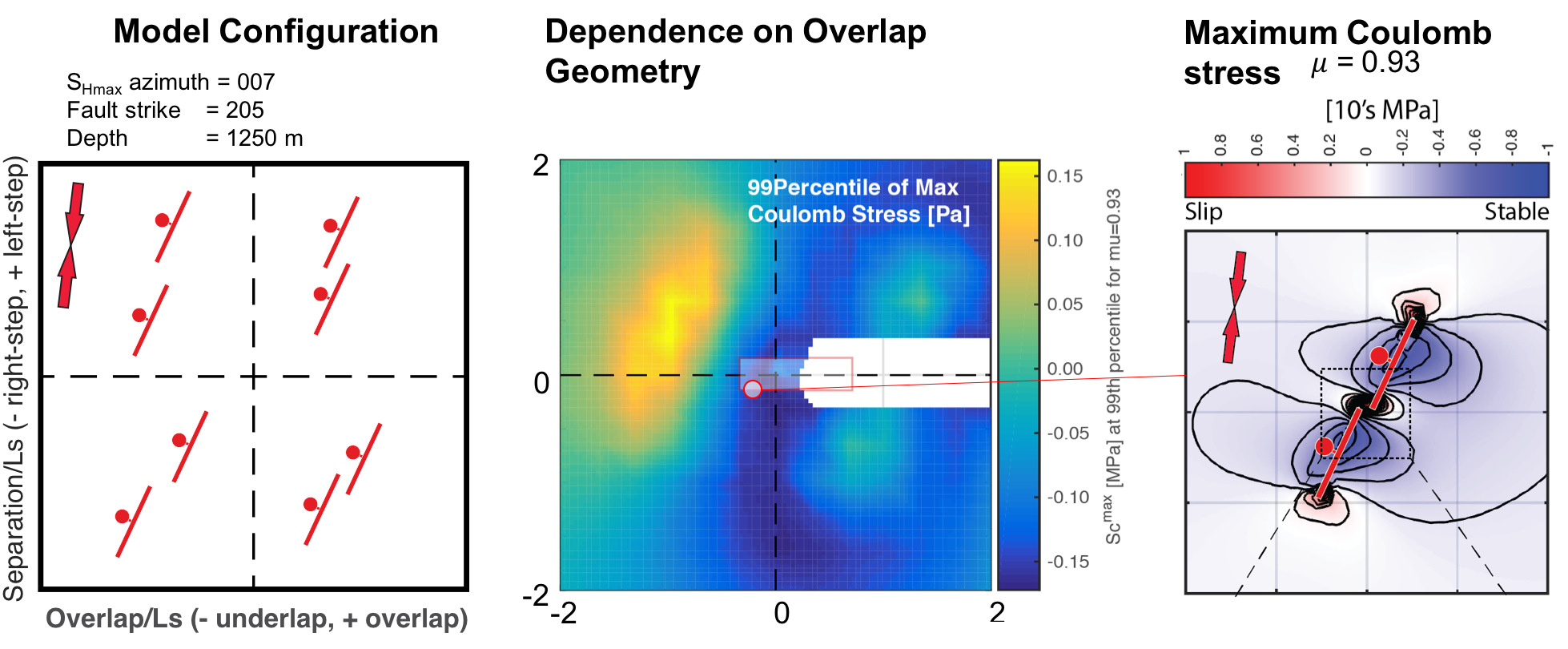 Summary of local stress state in the overlap between two en echelon faults for various spacing configurations. Left: Idealized overlap geometry. Middle: Summary of max coulomb stress in the region between the two simulated faults. Right: stress induced by slip on an example fault model. |
- Laboso, R. C. (2016). Fault-controlled damage and permeability at the brady geothermal system, Nevada, U.S.A (Order No. 10193609). Available from ProQuest Dissertations & Theses A&I. (1858814864).
-
Laboso, R.C., N.C. Davatzes (2016), Fault-Controlled Damage and Permeability at the Brady Geothermal System,Nevada, USA, Proceedings, 41st Workshop on Geothermal Reservoir Engineering, Stanford University, Stanford, California, February 22-24, 16p.
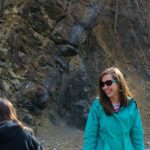 Olivia Wells (thesis; paper) (MS TU)
Olivia Wells (thesis; paper) (MS TU)
Investigation of the evolution of fracture roughness and dilation accompanying repeated slip with implications for developing an enhanced geothermal system (EGS) at Newberry Volcano, OR.
 Analysis of dilation history associated with repeated slip on natural fractures in core from well GEO N-2 in the flank of the Newberry Volcano. The pattern reveals two stages of dilation: (1) In the first stage, dilation correlates with primary grain size; (2) In the second stage, dilation is dictated by the linkage of early fractures and natural flaws. The first phase results in significant overall gain in small pores and potential storage for reservoir fluids whereas the second phase results in the largest pore sizes and thus potential increases in permeability. |
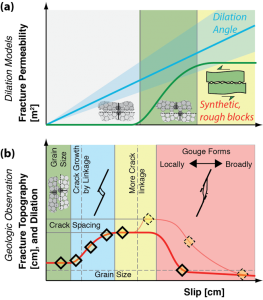 Conceptual model of the non-linear evolution of secondary porosity as slip increases. Both the grain size of the rock and initial distribution of flaws (small fractures, vugs or vesicles, etc.) control porosity production at small slip. As slip progresses past a critical distance, asperity destruction, gouge production, and fluid-assisted re-mineralization govern a transition to porosity loss. |
-
Wells, O. L. (2015). The evolution of fracture surface roughness and its dependence on slip (Order No. 1597133). Available from ProQuest Dissertations & Theses A&I. (1710061932).Wells, O.L. and Davatzes, N.C. (2015) The history of dilation across natural fractures due to evolving surface roughness, Proceedings, Fortieth Workshop on Geothermal Reservoir Engineering, Stanford University, Stanford, California, January 28-28, 2015, 12 p.
 Justin Roth (thesis; paper) (MS TU)
Justin Roth (thesis; paper) (MS TU)
Investigation of two- and three-dimensional porosity structure in fractured volcanic rocks at Newberry Volcano, OR with implications for geothermal resource potential.
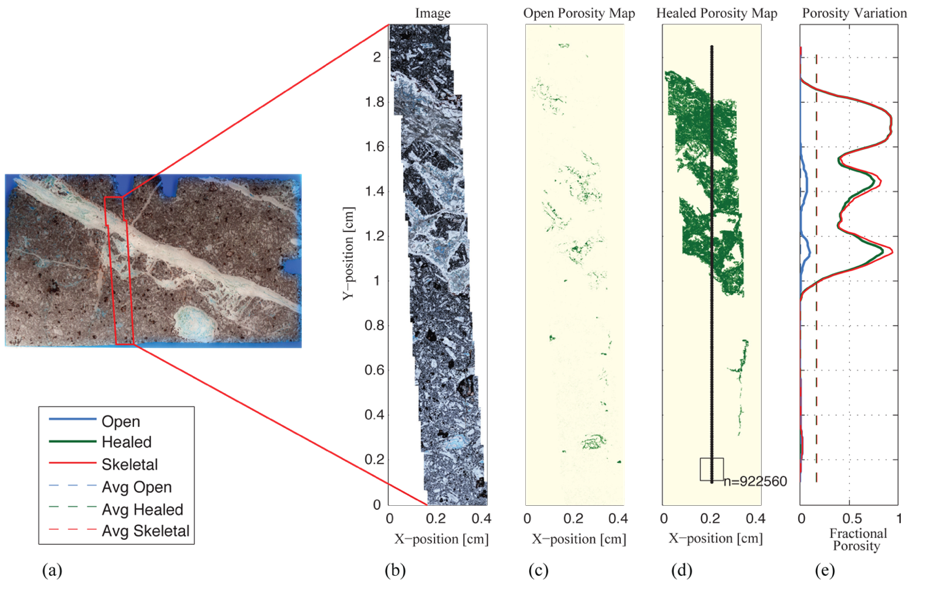 Detailed mapping of porosity structure in a multiply reactivated natural fracture from GEO N-2 core in the flank of the Newberry Volcano. |
- Roth, J. M. (2014). Investigating the volume and structure of porosity in fractured and unfractured rocks from the newberry volcano, oregon: An evaluation and comparison of two- and three-dimensional methods (Order No. 1552297). Available from ProQuest Dissertations & Theses A&I. (1501655565).
- Roth, J., Davatzes, N.C., Davatzes, A.E.K. (2013) Investigating the volume and structure of porosity in fractured and unfractured rock from the Newberry volcano, Oregon, USA: Evaluation of two- and three-dimensional methods. Geothermal Resources Council Annual Meeting, Las Vegas, NV, September 29-October 2, 2013. 10 p.
 Michael Swyer (thesis: paper 1, paper 2) (MS TU)
Michael Swyer (thesis: paper 1, paper 2) (MS TU)
Impact of rock mechanical properties and potential slip on the rhyolite ridge fault in the Desert Peak geothermal field, NV on the potential to expand the resource into hot impermeable rock.
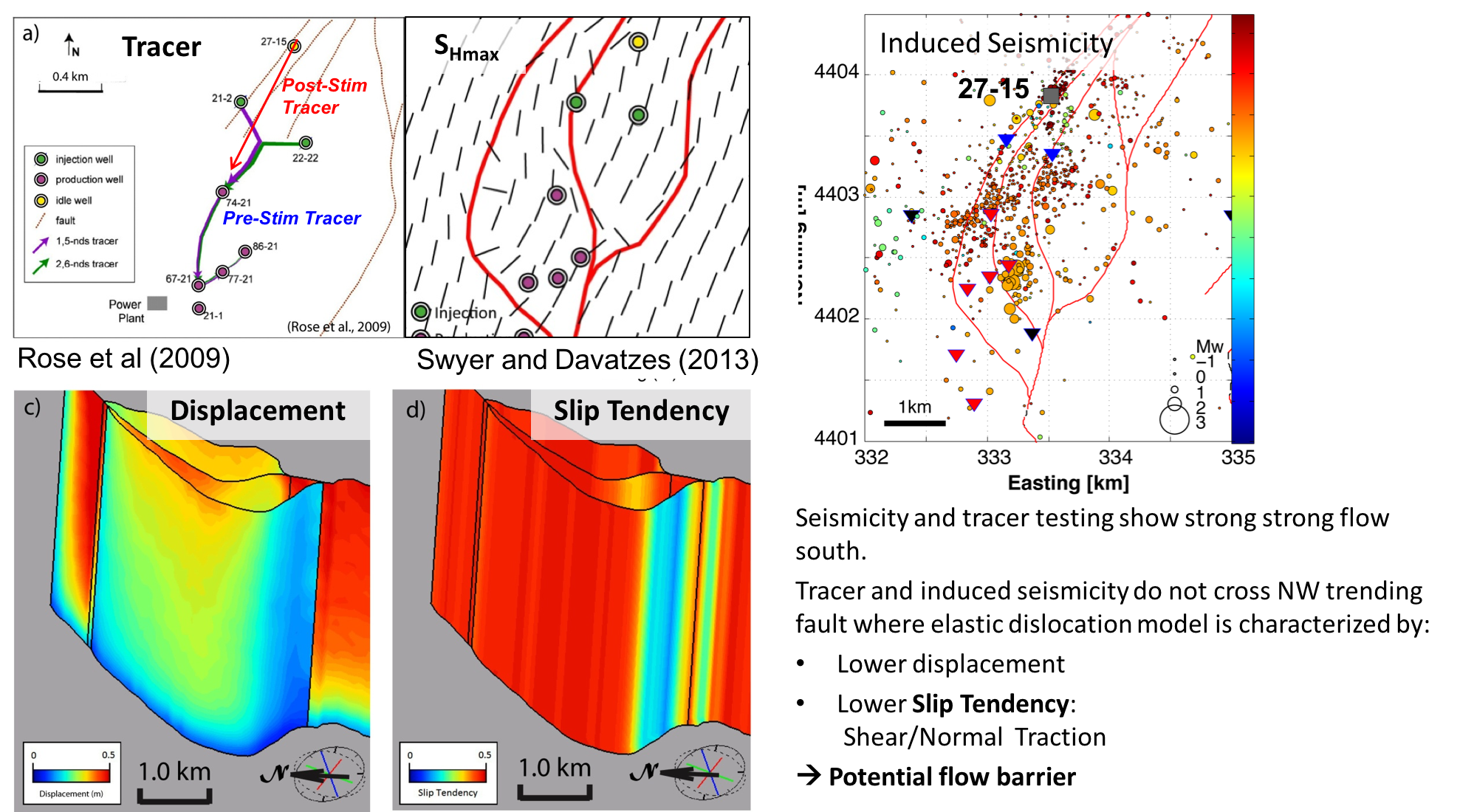 (a) Tracer analysis shows pre-stimulation isolation of well 27-15 and post-stimulation connection. (b) Simulated direction of SHmax due to slip on the Rhyolite Ridge fault to remote loading by Basin and Range Extension. In normal fault stress regimes it is assumed this coincides with the preferred strike of normal faults and joints. (c) Slip and (d) slip tendency (ration of shear to effective normal tractions) simulated on the Rhyolite Ridge fault. (e) Seismicity in the vicinity of the geothermal field (re-injection wells are blue, production wells are red, and the study site is a gray square). |
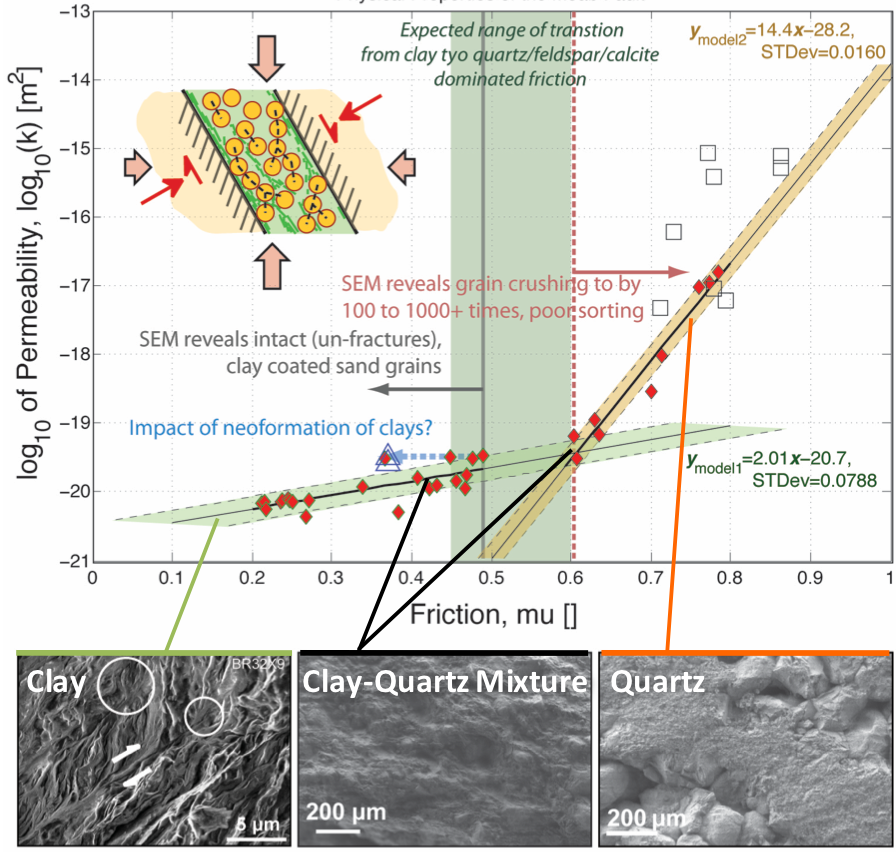 Analysis of how clay in fault rock controls key fault properties. Increasing clay content reduces both the friction and permeability of fault rock. The relationship is non -linear; a clay fraction beyond a critical threshold is associated with a transition to the clay-end member properties. The properties and critical clay-fraction are mineral dependent. (This analysis was performed at the USGS rock mechanics laboratory as a summer research project by Mike separate from the main focus of his thesis work.) |
- Swyer, M. W. (2013). Evaluating the role of the rhyolite ridge fault system in the desert peak geothermal field, NV: Boundary element modeling of fracture potential in proximity of fault slip (Order No. 1533315). Available from ProQuest Dissertations & Theses A&I. (1294851926).
- Swyer, M.W. and Davatzes, N.C. (2013) Evaluating the role of the Rhyolite Ridge fault system in the Desert Peak Geothermal Field with robust sensitivity testing through boundary element modeling and likelihood analysis, PROCEEDINGS, Thirty-Eight Workshop on Geothermal Reservoir Engineering, Stanford, California, February 11-February 13, SGP-TR-194, 16 p.
-
Swyer, M.W. and Davatzes, N.C. (2012) Using Boundary Element Modeling of Fault Slip to Predict Patterns of stress Perturbation and Related Fractures in Geothermal Reservoirs and Explore Parameter Uncertainty, Proceedings, Thirty-Seventh Workshop on Geothermal Reservoir Engineering, Stanford, California, January 30-February 1, SGP-TR-194, 14 p.
 Kelly Blake (thesis; paper 1, paper 2) (MS TU)
Kelly Blake (thesis; paper 1, paper 2) (MS TU)
Analysis of stress heterogeneity in the vicinity of the Coso Geothermal field, CA.
 (left) Visualization of stress concentration around a borehole can (middle left)) induce tensile or compressive failure of the borehole wall evident in acoustic (resistivity, and optical) image logs. (middle right) The shape and position of these structures same the stress state resolved on the borehole wall and is used to infer the local stress tensor. (right) In Coso and other sites we observe that the directions in which the principal stresses acts varies along the borehole relative to an overall mean. This variation occurs within a family of wavelengths and amplitudes whose relative contribution is assessed as a power spectral density. |
 Map of the preferred direction of SHmax +/- one standard deviation in geothermal fields in the west-central Basin and Range of Nevada. In normal faulting terrains, SHmax is generally expected to align with the strike of active normal faults that define the ranges and will be orthogonal to the overall extension direction expressed by the gradient in the GPS velocity vector field. |
- Blake, K. (2011). Crustal stress heterogeneity in the vicinity of a geothermal field: Coso geothermal field, CA (Order No. 1500799). Available from ProQuest Dissertations & Theses A&I. (900865609).
- Blake, K. and Davatzes, N.C. (2012) Borehole Image Log and Statistical Analysis of FOH-3D, Fallon Naval Air Station, NV, Proceedings, Thirty-Seventh Workshop on Geothermal Reservoir Engineering, Stanford, California, January 30-February 1, SGP-TR-194, 14 p.
- Blake, K. and Davatzes, N.C. (2011) Stress Heterogeneity in the Vicinity of the Coso Geothermal Field. Proceedings Thirty-Fifth Workshop on Geothermal Reservoir Engineering, Stanford University, Stanford, California. 11 p.
 Nwachukwu Anyamele (thesis; abstract) (MS TU)
Nwachukwu Anyamele (thesis; abstract) (MS TU)
Investigation of the source of clay in the Moab Fault, UT.
 Conceptual model of how faults can incorporate clay-rich material into a fault zone crossing layered sandstone and shale. |
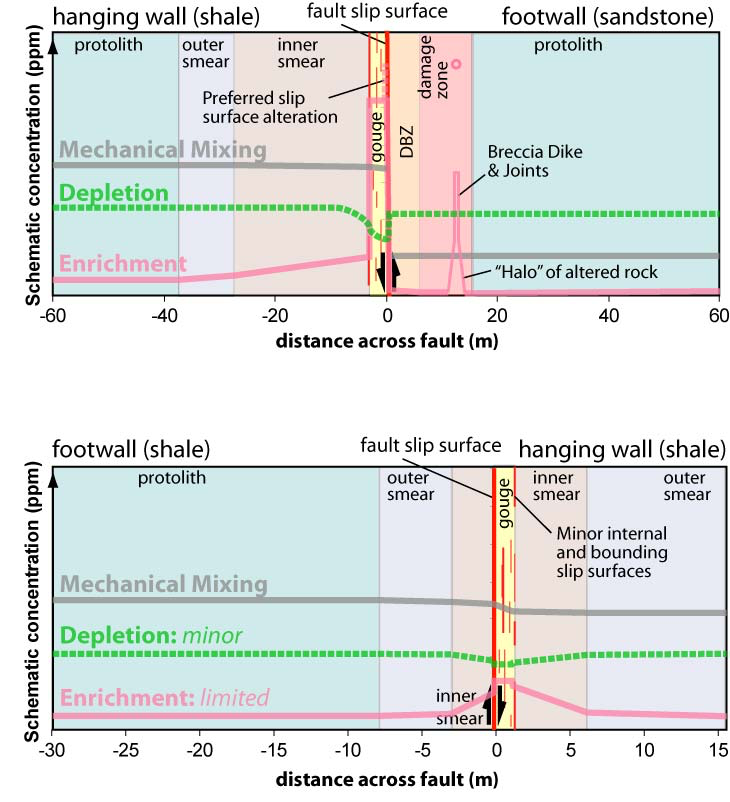 A key issue in fault zone development is the source of fault rock, which can be a combination of mechanically incorporated host rock or authigenically precipitated minerals. Formation of new minerals is promoted by mechanical fracture and grain size reduction exposing new, larger surface area to reaction and simultaneously facilitating fluid flow. In the fault zone we can explore the relative contribution of these two mechanisms by comparing the mineralogy and chemistry of a sample of fault rock to the host rocks dragged past the sample location. |
-
Anyamele, N., Davatzes, N.C., and Solum, J. G. (2009). Sources of clay in fault rock of the Moab Fault, Utah. American Association of Petrolem Geologists/Society for Sedimentary Geology joint annual meeting, Denver, Colorado.
 Joseph Batir (thesis; paper) (MS RES)
Joseph Batir (thesis; paper) (MS RES)
Investigating the stress state of the Hellisheidi geothermal field, IS.
 Observations of stress in Iceland from the world stress map. |
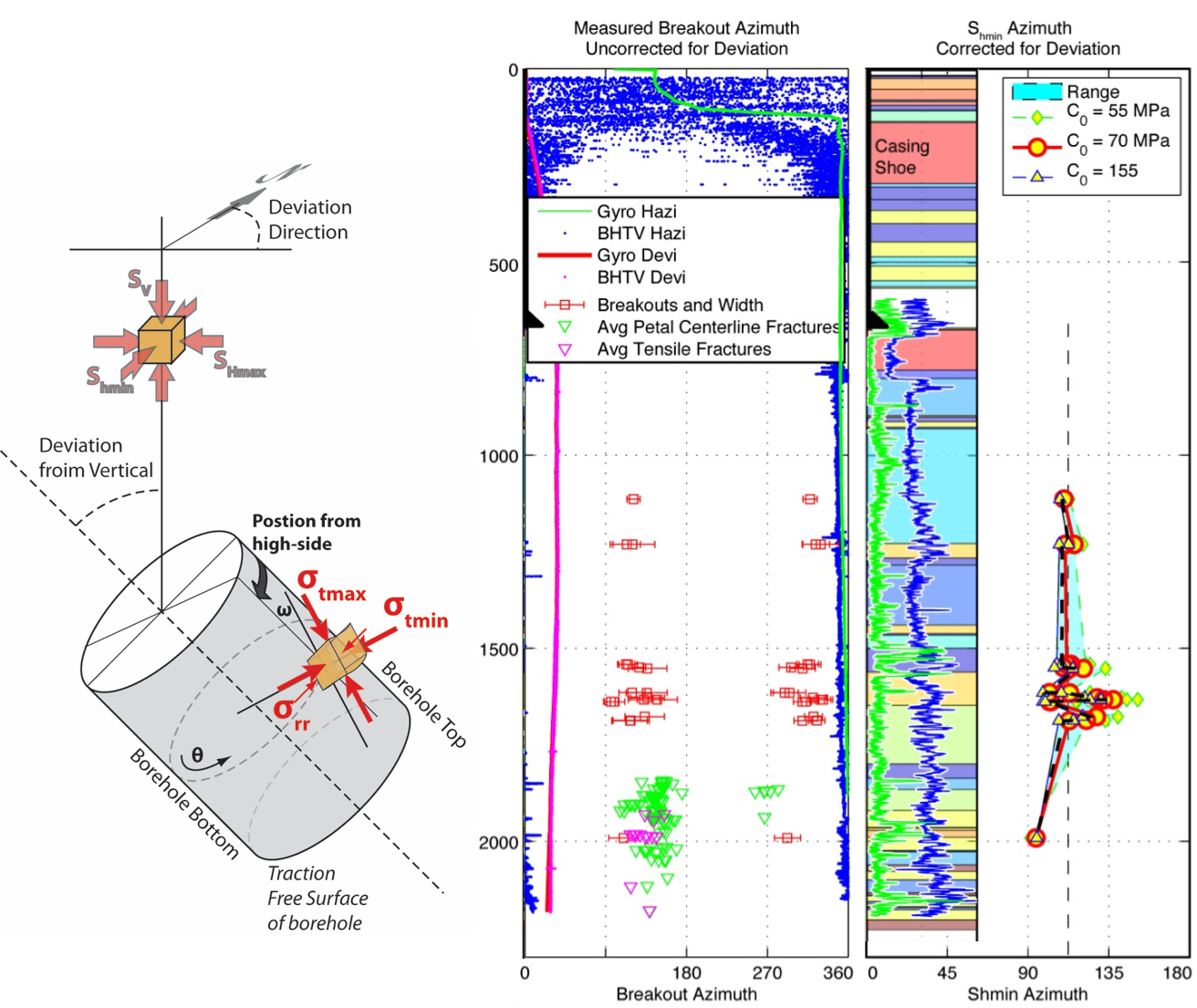 Resolution of the stress tensor onto an arbitrarily oriented borehole surface. The cavity introduced by the borehole concentrates the stress which can cause the borehole wall to fail. The position and shape of these failure structures is used to infer the stress state (direction of principal stresses and their magnitudes) in the rock where they occur. (left) Illustration of the relationship between the borehole and stress tensor. (middle) Position of induced borehole failure structures on the deviated borehole surface as well as deviation data. (right) Model of SHmax azimuth as constrained by a vertical stress calculated from a model of rock density and a model of the unconfined compressive rock strength. |
-
Batir, J., Davatzes, N.C., and Asmundsson, R. (2012) Preliminary State of Stress of the Hellisheidi Geothermal Field, Hengill Volcanic Zone, Iceland, Proceedings, Thirty-Seventh Workshop on Geothermal Reservoir Engineering, Stanford, California, January 30-February 1, SGP-TR-194, 17 p.
 Drew Fetterman (thesis; paper) (MS RES)
Drew Fetterman (thesis; paper) (MS RES)
Investigation of the porosity history of natural fractures in volcanic rock of the Newberry Volcano, OR.
 Porosity mapped in GEO N-2 core from the flank of the Newberry Volcano. |
 Fracture thickness and porosity observed in core from GEO N-2 in the flank of the Newberry Volcano, OR. Mapping of component structures is used to infer the relative accumulated slip and maturity of the fractures. Red indicates fractures with abundant quartz and calcite relative to phyllosilicates. Blue indicates fractures relatively enriched in phyllosilicates. |
-
Fetterman, J.D. and Davatzes, N.C. (2011) Evolution of Fracture Porosity in the Newberry Volcano Geothermal System, Oregon, USA: Feedback between deformation and alteration. Geothermal Resources Council Annual Meeting, San Diego, CA. 7 p.
 Amelia Letvin (thesis) (MS RES)
Amelia Letvin (thesis) (MS RES)
Mineralogy and alteration history along the Enhanced Geothermal Systems (EGS) test well 55-29, Newberry Volcano, OR.
 Summary of characteristics along EGS test well NWG 55-29. (panel 1) Relative abundance of cuttings minerals. (panel 2) Natural gamma radiation. (panel 3) Density log and estimated density from cuttings mineralogy weight percentage. (panel 4) Porosity log. (panel 5) Mud losses encountered during drilling. |
 Tryana Garza-Cruz (thesis; paper) (MS RES)
Tryana Garza-Cruz (thesis; paper) (MS RES)
Investigation of the stress concentration at the bottom of a borehole, its potential to induce tensile failure, and the implication for interpreting stress from induced borehole failure from image logs.
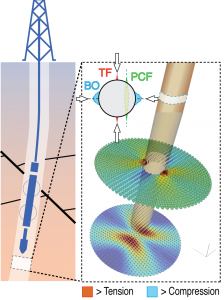 Visualization of the stress concentration along the sides and below the bottom of a borehole. Analysis performed in Poly3D in collaboration with IGEOSS. |
-
Garza-Cruz, T. & Davatzes, N.C. (2010): Numerical Modeling of the nucleation conditions of drilling-induced Petal Centerline Fracture. Geothermal Resources Council. Best Paper Award!
For a perspective on the Department of Earth and Environmental Sciences, please visit the department website.
v2022-12-12, © Nicholas C. Davatzes, 2022

